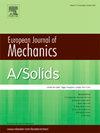Wave propagation in nonviscously damped phononic materials via precise integration method and deep learning
IF 4.4
2区 工程技术
Q1 MECHANICS
引用次数: 0
Abstract
The sensitivity of time-step size in direct integration methods presents significant challenges in achieving high computational accuracy, performing precise hysteresis analysis, and integrating deep neural networks into the study of wave propagation in nonviscously damped phononic materials. Addressing these challenges necessitates a reliable method capable of accurately analyzing wave propagation in such materials. Motivated by these needs, this paper introduces a precise direct integration method (PDIM) for transient wave propagation analysis in phononic materials. The proposed method incorporates an anelastic displacement field (ADF) model to account for complex, frequency-dependent damping behaviors while maintaining minimal model-order requirements. Two asymmetric state-space formulations based on Bloch–Floquet theory are derived to construct eigenvalue problems. To efficiently determine the dissipation behavior of propagating waves in phononic materials, a PDIM based on an asymmetric state-space formulation is developed. Wave propagation behavior in phononic materials is investigated using numerical examples, including a diatomic lattice structure, a multi-frequency vibration absorber, and a nonviscously damped rod. Using experimental datasets, the force–displacement hysteresis behavior of the ADF model is analyzed to accurately characterize the energy dissipation of the multi-frequency vibration absorber. The performance of the PDIM is compared to that of the existing accurate methods and the finite element time domain (FETD) method from the literature, with evaluations based on implementation, accuracy, stability, and precision. The PDIM provides precise results that approach accurate solutions across different time steps. By eliminating the need for acceleration calculations at each time step, the PDIM demonstrates a significant advantage over the FETD method. To solve wave propagation problems in a diatomic lattice structure, a comparative study between the PDIM and physics-informed neural networks (PINNs) is conducted. With carefully designed network architecture, PINNs show promising results that closely match the predictions obtained from the PDIM. Additionally, the nonviscous damping effect on the wave propagation characteristics of phononic materials is analyzed, revealing that viscoelasticity contributes to the widening of the bandgaps in nonviscously damped phononic materials.
求助全文
约1分钟内获得全文
求助全文
来源期刊
CiteScore
7.00
自引率
7.30%
发文量
275
审稿时长
48 days
期刊介绍:
The European Journal of Mechanics endash; A/Solids continues to publish articles in English in all areas of Solid Mechanics from the physical and mathematical basis to materials engineering, technological applications and methods of modern computational mechanics, both pure and applied research.

 求助内容:
求助内容: 应助结果提醒方式:
应助结果提醒方式:


